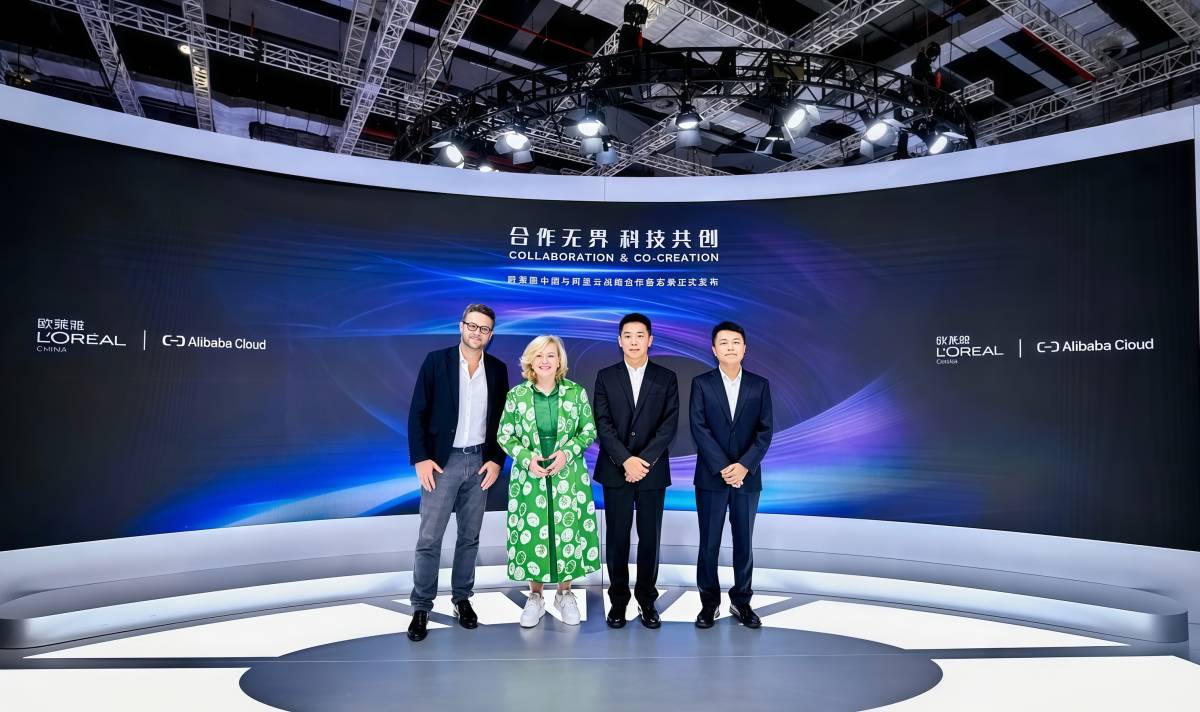L’Oréal China and Alibaba Cloud Announce Full-Stack AI Collaboration to Accelerate Beauty Innovation and Efficiency – Alizila

Strategic Collaboration Report: L’Oréal China and Alibaba Cloud Partnership for AI-Driven Sustainable Innovation
1.0 Executive Summary
L’Oréal China has entered into a strategic collaboration with Alibaba Cloud to integrate full-stack Artificial Intelligence (AI) across its business operations. This partnership leverages Alibaba Cloud’s advanced Qwen-based AI capabilities to enhance operational efficiency, consumer experiences, and research and innovation (R&I). A central pillar of this initiative is the alignment of technological advancement with key United Nations Sustainable Development Goals (SDGs), aiming to establish new industry benchmarks for responsible and sustainable technology in the beauty sector.
2.0 Core Objectives and Technological Implementation
The collaboration is designed to deploy AI solutions across multiple business functions. The primary objectives are outlined as follows:
- Enhance Operational Efficiency: Utilize AI to streamline internal processes and accelerate development cycles.
- Deployment of an AI coding assistant for L’Oréal China’s IT organization to expedite software development.
- Creation of an agentic application powered by a comprehensive knowledge base to improve communication efficiency for skincare practitioners.
- Elevate Consumer Engagement: Implement intelligent systems to deliver personalized and accurate consumer interactions.
- Application of AI in intelligent customer service and marketing to create tailored consumer experiences.
- Accelerate Research & Innovation: Combine L’Oréal’s industry expertise with Alibaba Cloud’s AI capabilities to fast-track product R&I and design, fostering innovation within the beauty industry.
3.0 Alignment with Sustainable Development Goals (SDGs)
This partnership demonstrates a profound commitment to sustainable development by integrating responsible practices into its technological framework. The collaboration directly contributes to several SDGs:
-
SDG 9: Industry, Innovation, and Infrastructure
The initiative is a prime example of fostering innovation and building resilient infrastructure. By deploying cutting-edge AI, the partnership aims to upgrade the technological foundation of the beauty industry, promoting sustainable industrialization and setting a new benchmark for “Beauty Tech.”
-
SDG 12: Responsible Consumption and Production
The collaboration promotes sustainable production patterns through enhanced efficiency and personalization. AI-driven operational improvements can lead to optimized resource allocation and waste reduction. Furthermore, personalized consumer insights help create products that meet specific needs, potentially reducing over-consumption and product waste.
-
SDG 8: Decent Work and Economic Growth
A key component of the agreement is a comprehensive AI training and certification program provided by Alibaba Cloud. This initiative supports the creation of a future-ready workforce by upskilling L’Oréal China teams, thereby promoting sustained, inclusive economic growth and productive employment in an increasingly digital economy.
-
SDG 17: Partnerships for the Goals
The strategic alliance between L’Oréal China, a global beauty leader, and Alibaba Cloud, a technology giant, exemplifies a multi-stakeholder partnership. This co-creation model is essential for mobilizing and sharing knowledge, technology, and resources to support the achievement of the Sustainable Development Goals on a global scale.
4.0 Future Outlook
The collaboration between L’Oréal China and Alibaba Cloud is poised to redefine the intersection of technology, personalization, and sustainability in the beauty industry. By leveraging AI for operational excellence and innovative R&I, the partnership aims not only to achieve digital transformation but also to establish a new standard for sustainable and responsible business practices. This initiative serves as a benchmark for the consumer goods industry, demonstrating how technological advancement can be harmonized with global sustainability objectives.
Analysis of SDGs, Targets, and Indicators
1. Which SDGs are addressed or connected to the issues highlighted in the article?
-
SDG 4: Quality Education
The article mentions an “AI training and certification program to help L’Oréal China teams rapidly build AI literacy and application skills.” This initiative directly contributes to providing quality education and promoting lifelong learning opportunities, specifically in the area of advanced technology skills for the workforce.
-
SDG 8: Decent Work and Economic Growth
The collaboration aims to “boost operational efficiency” and “accelerate software development” through the use of AI. This focus on technological upgrading and innovation to improve economic productivity aligns with the goal of achieving sustainable economic growth.
-
SDG 9: Industry, Innovation, and Infrastructure
This is a central theme of the article. The partnership is designed to “deploy full-stack AI,” “advance technological innovation across the beauty industry,” and “accelerate the product R&I and design.” This directly supports the goal of building resilient infrastructure, promoting inclusive and sustainable industrialization, and fostering innovation.
-
SDG 17: Partnerships for the Goals
The entire article is about a “strategic collaboration” between two major private sector entities, L’Oréal China and Alibaba Cloud. This partnership to share technology, knowledge, and expertise to achieve common goals is a clear example of a multi-stakeholder partnership as envisioned by SDG 17.
2. What specific targets under those SDGs can be identified based on the article’s content?
-
Target 4.4: “By 2030, substantially increase the number of youth and adults who have relevant skills, including technical and vocational skills, for employment, decent jobs and entrepreneurship.”
The plan for Alibaba Cloud to provide a “comprehensive AI training and certification program to help L’Oréal China teams rapidly build AI literacy and application skills” directly addresses the need to equip the adult workforce with relevant technical skills for a future-ready organization.
-
Target 8.2: “Achieve higher levels of economic productivity through diversification, technological upgrading and innovation…”
The collaboration’s aim to “boost operational efficiency” and “elevate consumer experiences” by leveraging “full-stack AI” and “advanced infrastructure” is a direct effort to achieve higher productivity through technological upgrading and innovation.
-
Target 9.5: “Enhance scientific research, upgrade the technological capabilities of industrial sectors in all countries… encouraging innovation…”
The partnership’s goal to “accelerate the product R&I and design in beauty industry” and “advance technological innovation” by combining L’Oréal’s industry expertise with Alibaba Cloud’s AI capabilities is a direct implementation of this target.
-
Target 17.17: “Encourage and promote effective public, public-private and civil society partnerships, building on the experience and resourcing strategies of partnerships.”
The “strategic collaboration” between L’Oréal China and Alibaba Cloud is a prime example of a private-private partnership that mobilizes technology and expertise to drive innovation, aligning with the spirit of this target.
3. Are there any indicators mentioned or implied in the article that can be used to measure progress towards the identified targets?
- For Target 4.4: An implied indicator is the number of L’Oréal employees who complete the AI training and certification program. The article explicitly mentions the provision of this program, making its uptake a measurable outcome.
- For Target 8.2: A key implied indicator is the measured increase in operational efficiency. The article states that a primary goal is to “boost operational efficiency,” which can be tracked through internal business metrics.
- For Target 9.5: An implied indicator is the acceleration in the R&I and software development cycles. The article mentions the adoption of an “AI coding assistant, to accelerate software development” and the goal to “accelerate the product R&I,” suggesting that the speed of innovation is a key performance metric.
- For Target 17.17: The primary indicator is the existence and successful implementation of the strategic collaboration itself. The announcement and ongoing activities of the partnership serve as a direct indicator of progress.
4. Summary Table of SDGs, Targets, and Indicators
| SDGs | Targets | Indicators (Identified or Implied in the Article) |
|---|---|---|
| SDG 4: Quality Education | 4.4: Increase the number of adults with relevant technical skills for employment. | Number of employees completing the AI training and certification program. |
| SDG 8: Decent Work and Economic Growth | 8.2: Achieve higher levels of economic productivity through technological upgrading and innovation. | Measured increase in operational efficiency. |
| SDG 9: Industry, Innovation, and Infrastructure | 9.5: Enhance scientific research and upgrade technological capabilities to encourage innovation. | Rate of acceleration in product R&I and software development cycles. |
| SDG 17: Partnerships for the Goals | 17.17: Encourage and promote effective private-private partnerships. | The establishment and implementation of the strategic collaboration between L’Oréal China and Alibaba Cloud. |
Source: alizila.com
What is Your Reaction?
 Like
0
Like
0
 Dislike
0
Dislike
0
 Love
0
Love
0
 Funny
0
Funny
0
 Angry
0
Angry
0
 Sad
0
Sad
0
 Wow
0
Wow
0
















































/environment-climate-change-and-health-(ech)/water-sanitation-hygiene-and-health-(wsh)/landfill-tuvalu-36092.tmb-1200v.jpg?sfvrsn=5c21fe40_1#)

.jpg.webp?itok=0ZsAnae9#)

























